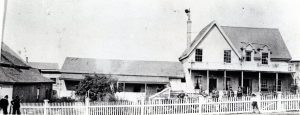 When Little River was starting to hum with a mill, mill workers, and more folks settling in the area in the mid-1860s, the Pioneer Hotel would have been the only place to get a drink. The owner, August Frederick Mahlman, who had been working in the mills, realized that the growing community needed lodging and libations, so he built his hotel, which had rooms for his family, a large hall for community events, a saloon and restaurant, and in the back, a livery stable and a large barn for the mill oxen when they weren’t being used to haul logs. Eventually there was even roller-skating.
When Little River was starting to hum with a mill, mill workers, and more folks settling in the area in the mid-1860s, the Pioneer Hotel would have been the only place to get a drink. The owner, August Frederick Mahlman, who had been working in the mills, realized that the growing community needed lodging and libations, so he built his hotel, which had rooms for his family, a large hall for community events, a saloon and restaurant, and in the back, a livery stable and a large barn for the mill oxen when they weren’t being used to haul logs. Eventually there was even roller-skating.
The first of the new locals, who were mostly Quakers, Seventh Day Adventists, and prohibitionists, complained to Mahlman about offering liquor. Those population demographics also explain why there was never a little white church in Little River. There was a steeple, however, a belfry actually, on the Little River Schoolhouse. For a while that belfry was also on the roof of the Good Templars Hall. No one knows when or why it was erected there or what happened to it or the bell. According to Mrs. Barton, one of August Mahlman’s daughters, the bell came from the 1883 wreck of the Chilean bark, Maria Marino.
Where was I? Oh, back to the bar story: Mahlman was undeterred by the complaints, stating, “If you promise not to come into my bar, I promise not to serve you.” Ironically, the complaining folks eventually used the hotel’s community room for meetings until their own hall was built across the street — the International Order of Good Templars — an anti-liquor society. This building still exists, now known as the Little River Improvement Club.
August Mahlman must have been an interesting fellow to chat with since he had an education in a wide range of subjects such as baking, taxidermy and botany. A native of Germany, he also had traveled widely in pursuit of career options before arriving in the U.S., first in New York, then the gold fields of California, before settling in Little River. He was well known for his gardening including a variety of plants from seeds and cuttings brought to him from sailors and sea captains. He liked to have a little fun too. He’s remembered for tinting some pampas grass in a variety of colors which had the locals buzzing — and fooled — until the dyes started to fade away.
His Danish wife, Amelia Andersen, was helpful with the hotel and restaurant. Together they raised their four children, two sons and two daughters, and Amelia’s daughter from a previous marriage.
In later years there were other places in Little River that offered liquor — Norager’s Hotel, for instance, and Corrigan’s store. Next time you’re having a drink in the Little River Inn bar, get off the stool and take a look at the photo of early Little River just to the left of the dining room entrance. At the top row of white structures, The Pioneer Hotel is about 5 inches from the left with two upstairs windows, something dark like an unpainted porch in the front, and a long white picket fence extending to the right. When you’re back in your place at the bar, raise a toast to August Mahlman, Little River’s first bar keeper.
Photo caption: The Mahlman Hotel, built at Little River in 1864 as the Pioneer House.